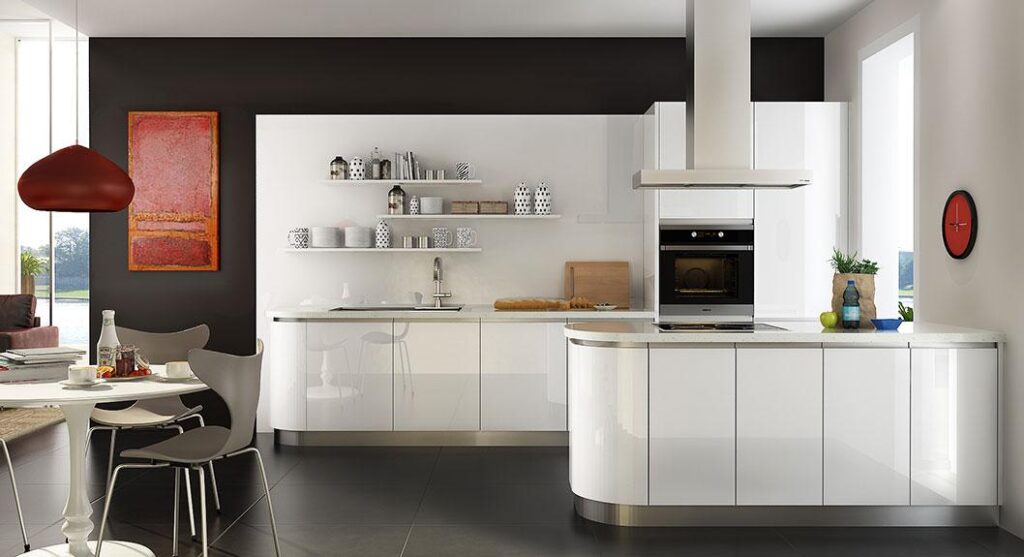The galley kitchen—characterized by its parallel walls and narrow footprint—presents both unique challenges and surprising opportunities in residential design. When this configuration measures less than eight feet in width, every inch must be meticulously considered to create functional, aesthetically pleasing spaces.
Far from being design limitations, these narrow dimensions can inspire highly customized solutions that often outperform larger kitchens in efficiency and workflow optimization.
Understanding the Galley Kitchen Dynamics
Galley kitchens emerged from maritime design, where ship galleys demanded maximum functionality within severely limited space. This origin explains their inherent efficiency—a well-designed galley kitchen minimizes movement while maximizing productivity. The parallel layout naturally creates the ideal work triangle between refrigeration, cooking, and cleaning zones.
In my experience working with urban apartments and historic homes, galley kitchens under eight feet frequently become clients’ favorite rooms after thoughtful renovation. One client initially apologized for her “cramped” kitchen during our first meeting, yet after implementing custom solutions, she later confessed to preferring it over the sprawling kitchen in her previous suburban home—primarily due to its efficiency during meal preparation.
The psychological experience of narrow galleys depends heavily on design execution. Poorly conceived spaces feel claustrophobic and restrictive, while thoughtfully customized versions feel intimate and intuitive. This stark contrast explains why custom solutions prove particularly valuable in these challenging dimensions.
Optimizing Layout Within Tight Constraints The Critical Clearance Question
The fundamental challenge in sub-8-foot galleys involves clearance—the space between opposing countertops or appliances. Industry standards recommend 42-48 inches for comfortable two-cook kitchens, leaving precious little space for cabinetry and countertops in very narrow galleys.
For kitchens measuring 7’6″ (90″) or less in total width, custom solutions become essential rather than optional. Standard 24″ deep base cabinets on both walls would leave just 42″ of clearance—the bare minimum for functional passage. Any appliance doors or hardware further reduces this clearance during use.
Case studies show that reducing standard cabinet depth on one wall often yields better results than symmetrical shallow cabinets on both sides. This approach preserves full functionality on the “primary” wall while creating adequate clearance throughout the space.
The Single-Wall Appliance Strategy
Placing all major appliances along a single wall allows the opposite wall to feature shallower cabinetry (15-18″ deep instead of 24″). This asymmetrical approach maximizes clearance while maintaining functionality. The deeper wall accommodates standard appliances, while the shallower wall provides ample storage without impeding movement.
Have you considered how workflow patterns might influence which wall receives standard depth treatment? For right-handed cooks, placing the deeper cabinetry and appliances on the left wall often improves ergonomics, allowing the dominant hand greater freedom of movement during meal preparation.
Custom Cabinetry SolutionsVertical Storage Maximization
When floor space is severely limited, vertical expansion becomes essential. Custom cabinetry solutions for narrow galleys typically include:
- Ceiling-height upper cabinets (extending to 96″ or higher rather than standard 84″)
- Integrated organization systems within tall cabinets (pull-out pantries, vertical dividers)
- Multi-tiered storage within each cabinet (adjustable shelving, drawer-within-drawer systems)
- Specialized storage zones for specific kitchen activities (baking, coffee preparation)
OPPEIN, which specializes in space-optimized designs, has developed pull-down systems that make upper reaches of tall cabinets accessible without step stools—a particular advantage in narrow spaces where ladders or steps create hazardous obstacles.
Counter-Depth Customization
Standard 24″ deep countertops may prove excessive in extremely narrow galleys. Custom solutions often include:
- 21″ depth counters on the primary wall
- 15-18″ depth counters on the secondary wall
- Corner treatments that eliminate sharp edges in high-traffic pathways
- Cantilevered sections that provide expanded work surfaces without obstructing floor clearance
I recently completed a 7’4″ wide galley renovation using 22″ depth on the appliance wall and 16″ on the opposing wall. The clients—avid cooks—report that the customized depths actually improved functionality by bringing frequently used items within easier reach compared to their previous standard-depth kitchen.
Drawer-Based Storage Systems
Traditional base cabinets with doors and shelves waste valuable space in tight kitchens. Custom drawer systems offer superior organization and accessibility:
- Full-extension drawer slides that utilize the entire cabinet depth
- Varied drawer heights customized to specific contents
- Internal drawer dividers configured for household-specific items
- Specialized inserts for cutlery, spices, and cooking tools
Many cabinet manufacturers now offer drawer-based storage systems as standard options, but custom versions can be tailored precisely to inventory needs rather than standardized dimensions.
Appliance Selection and Integration Scaled Appliances
European and compact appliances offer functionality without the oversized footprints common in American kitchens:
- 24″ refrigerators (counter-depth) instead of 36″ models
- 18-24″ dishwashers rather than standard 24″ units
- 24″ ranges instead of 30″ models
- Combination appliances that serve multiple functions (microwave-convection units)
These scaled appliances often deliver performance comparable to full-sized versions while preserving precious inches for storage and clearance.
Integrated and Panel-Ready Solutions
In extremely narrow galleys, visual continuity becomes particularly important for creating a sense of spaciousness. Custom panel-ready appliances allow seamless integration with cabinetry, reducing visual interruptions:
- Panel-front refrigerators that disappear into cabinetry lines
- Dishwashers with matching cabinet fronts
- Under-counter refrigerator drawers that replace portion of base cabinetry
- Ventilation systems concealed within cabinetry or ceilings
Would you believe that eliminating visible appliances can make a narrow kitchen appear up to 20% larger? This perceptual trick works particularly well in galleys, where continuous cabinetry creates unbroken lines that visually expand the space.
Material Selection for Visual Expansion Reflective Surfaces
Strategic use of reflective materials amplifies available light and creates visual expansion:
- Mirrored backsplashes in targeted areas
- High-gloss cabinet finishes that bounce light
- Polished countertop materials with reflective properties
- Metallic accent elements that add dimensional depth
Case studies show that adding just one mirror-finish element to a narrow galley significantly impacts spatial perception without creating disorienting or excessive reflection.
Light Color Palettes
While not mandatory, lighter colors generally enhance the sense of spaciousness in tight galleys:
- Tone-on-tone palettes that blur boundaries between surfaces
- Vertical striping effects that draw the eye upward
- Cabinet finishes that reflect rather than absorb light
- Strategic dark accents that create depth without overwhelming the space
Lighting Systems for Narrow Galleys
Lighting takes on outsized importance in tight kitchens, requiring customized approaches:
- Under-cabinet lighting on both walls to eliminate shadows
- Recessed ceiling fixtures that avoid protruding into the vertical envelope
- Internal cabinet lighting that improves visibility in deep storage areas
- Task lighting positioned to prevent users from working in their own shadow
In my experience designing narrow workspaces, layered lighting makes the most dramatic difference in how spacious a galley feels during use. One client described the transformation from a single-source overhead fixture to a custom multi-layered system as “like gaining two feet of width” in perceived spaciousness.
Custom Solutions for Specific Challenges The Refrigerator Dilemma
Standard refrigerators present particular challenges in sub-8-foot galleys, with several custom solutions available:
- Counter-depth models with panel fronts to minimize visual impact
- Column refrigerators with separate freezer units distributed through the kitchen
- Refrigerator drawers incorporated into base cabinetry
- Relocating refrigeration to adjacent spaces when possible
The Range Hood Question
Ventilation requirements can complicate galley designs, with custom options including:
- Ceiling-mounted extraction systems that eliminate wall-mounted hoods
- Microwave-hood combinations that serve dual purposes
- Down-draft systems integrated into cooktops
- Custom-sized hood inserts scaled precisely to cooking surfaces
The Psychological Element of Narrow Galleys
Beyond physical dimensions, design psychology significantly impacts how narrow kitchens feel during use:
- Visual connection to adjacent spaces creates perceived expansion
- Elimination of visual clutter through specialized storage
- Continuity of materials that prevent the eye from stopping abruptly
- Strategic focal points that draw attention away from dimensional constraints
The most successful narrow galleys acknowledge psychological comfort as equal in importance to physical functionality, addressing both through customized solutions.
The well-designed galley kitchen under 8 feet demonstrates that spatial limitations often inspire the most innovative design solutions. Through careful customization of cabinetry, appliances, materials, and layout, these compact kitchens can deliver exceptional functionality while providing distinctive character that their larger counterparts often lack. The key lies not in fighting against the inherent constraints but embracing them as opportunities for precision-tailored design.

